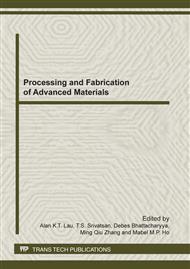p.353
p.357
p.361
p.366
p.370
p.377
p.382
p.386
p.390
Effects of Emulsion Electrospinning Parameters on the Morphology and Structure of Core-Shell Structured PLLA Fibers
Abstract:
Electrospinning is a popular technique for producing micro-or nanofibers for diverse applications including filtration, catalysis, sensors, cosmetics, wound dressing and tissue engineering. In some applications such as controlled drug/biomolecule delivery, core-shell structured nanofibers are desired. There are two major electrospinning processes for making core-shell structured fibers: emulsion electrospinning and coaxial electrospinning. In this study, the formation of core-shell structured fibers of poly (L-lactic acid) (PLLA) through emulsion electrospinning was investigated. To study the electrospinability of emulsions based on PLLA solutions, two solvents, pure chloroform and mixed solvent of chloroform and N,N-dimethylformamide, were used separately for making PLLA solutions. In the study of the formation of controlled release systems for biomolecules, bovine serum albumin, a model protein, was dissolved in de-ionized water to make the water phase in emulsions. In emulsion electrospinning, parameters such as applied voltage, working distance and feeding rate, were systematically investigated. The morphology, diameter and core-shell structure of emulsion electrospun fibers was studied using electron microscopies.
Info:
Periodical:
Pages:
386-389
Citation:
Online since:
November 2011
Keywords:
Price:
Сopyright:
© 2012 Trans Tech Publications Ltd. All Rights Reserved
Share:
Citation:


